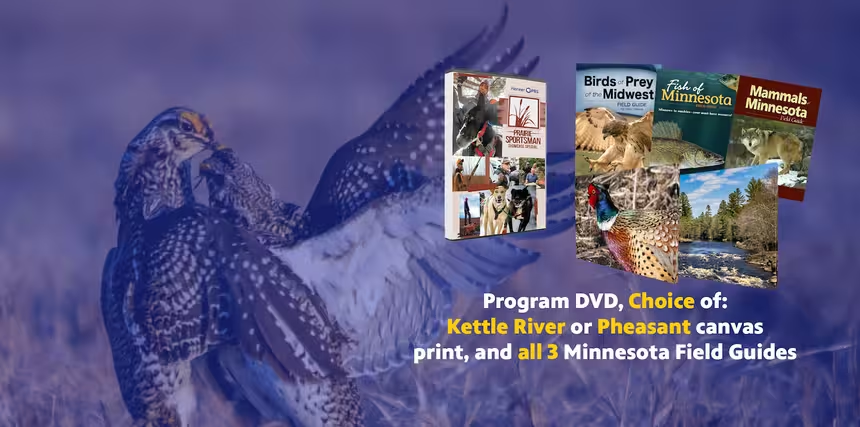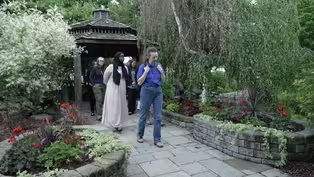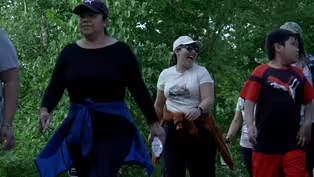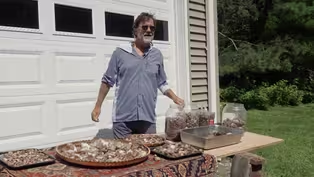Prairie Sportsman
The Healing Forest
Clip: Season 16 Episode 3 | 8m 13sVideo has Closed Captions
Forest therapy’s mental health benefits.
Sara Holger, the founder of Project Get Outdoors, helps youth leaders become certified forest therapy guides. Health professionals have found that when children spend more time outdoors, they are healthier, happier and do better in school. Sara is also introducing forest bathing to the medical community and led Olmsted Medical Center physicians in Rochester on a nature walk.
Problems playing video? | Closed Captioning Feedback
Problems playing video? | Closed Captioning Feedback
Prairie Sportsman is a local public television program presented by Pioneer PBS
Production sponsorship is provided by funding from the Environment and Natural Resources Trust Fund, West Central Initiative, Shalom Hill Farm, and members of Pioneer PBS.
Prairie Sportsman
The Healing Forest
Clip: Season 16 Episode 3 | 8m 13sVideo has Closed Captions
Sara Holger, the founder of Project Get Outdoors, helps youth leaders become certified forest therapy guides. Health professionals have found that when children spend more time outdoors, they are healthier, happier and do better in school. Sara is also introducing forest bathing to the medical community and led Olmsted Medical Center physicians in Rochester on a nature walk.
Problems playing video? | Closed Captioning Feedback
How to Watch Prairie Sportsman
Prairie Sportsman is available to stream on pbs.org and the free PBS App, available on iPhone, Apple TV, Android TV, Android smartphones, Amazon Fire TV, Amazon Fire Tablet, Roku, Samsung Smart TV, and Vizio.

Prairie Sportsman Premium Gifts
Do you love the great outdoors, hunting, fishing, hiking and conservation? Consider becoming a friend of Prairie Sportsman to support it and receive gifts with your contribution.Providing Support for PBS.org
Learn Moreabout PBS online sponsorship- [Sara] People when we get 'em out into nature, they feel like they're returning to their true self.
There's power, there's so much power in it.
I think it can change lives.
(pondering music) - [Narrator] Sara Holger says nature saved her life.
Years ago, the state park naturalist experienced depression and a divorce.
- When my kids would go to their dad's house, I would go to Whitewater State Park and I would sit on this bench by the river, that was my favorite spot and I would just sit there and I would look at the cliffs, look at the rocks, and I would think about, wow, you know, nature.
These rocks have been here for hundreds of millions of years and I'm just this little speck, you know, on the timescale.
I'm lucky if I get 80 years here And I started thinking, you know what, I don't be sitting here crying for those little 80 years that I have.
I wanna live my life, I wanna enjoy life, I wanna be happy.
- [Narrator] Sara turned the healing power of nature into a vocation, she founded Project Get Outdoors, a nonprofit afterschool program that connects kids to the natural world.
Then in 2021 she went through intensive training to become a certified nature and forest therapy guide.
- It had a profound impact on me.
- [Narrator] Sara wanted to bring forest therapy to local communities as she did with Project Go.
- How we can get more people certified was the thing, cause that's a barrier it's $4,000 at least to the Association of Nature and Forest Therapy Guides, which is the organization that I went through and they are an international leader in this training.
And then also find candidates who work with youth, work with BIPOC youth and youth experiencing trauma.
This project has bee supported by a mix of funders, most of them are coming from the healthcare realm.
We spend about a year recruiting folks.
So we reached out to different community organizations, a mix of clinics, mental health organizations, nonprofits that work with youth and underrepresented communities.
- [Narrator] 11 professionals from Southeast Minnesota and the Twin Cities signed up for a six month training course.
After completing 125 hours of online coursework, they agreed to lead at least six forest bathing walks with youth over the summer.
- It is a really a powerful way to engage with people.
We have some folks who are Spanish speakers and some folks that work with different communities.
(lively music) - [Narrator] One of those cohorts, Luisana Mendez is a St. Paul Civic Engineer and the founder of Huellas Latinas, a nonprofit that organizes outdoor activities for Spanish speaking communities.
- I was doing a partnershi with Minnesota Parks and Trails, a friend in common, Veronica, she told me, "Oh I know Sara and she do forest bathing.
You know what is forest bathing?
I was, "What is that?
What's mean be in the forest for a shower?"
Or something like that?
We traveled to meet Sara and Whitewater State Park and we did the forest bathing and was a great experience even it was so new for me, I am always very active and the forest bathing require you calm down a little bit.
The next year we partner again and we did another forest bathing walk.
After that she offered me the opportunity to become a forest bathing guide and that changed my life completely, and gimme another knowledge and skills I can share with the community.
(happy music) - [Narrator] Besides youth programs, Sara is introducing forest therapy to the medical community, including the Olmsted Medical Center in Rochester where she invited physicians on a nature walk.
- Forest bathing is a practice that originated in Japan.
It started in the 1980s, what we saw at that time in Japan then was a massive shift of people who were living in rura settings moving into the city.
So they were losing that connection to the countryside and the nature there.
And then also they were becoming more overworked.
People were literally working themselves to death, suicide rates were skyrocketing, all sorts of health problems and it was to the point where the Japanese government intervened and started looking at prevention strategies, and what they found was the nature-based strategies had the biggest impact.
So the idea of using your senses to soak in nature, thus the bathing term.
(peaceful music) You can adapt forest bathing in so many different ways, so if we would've had people in wheelchairs today, we maybe wouldn't have even moved.
We might've stayed under the gazebo the whole time.
So we're gonna be doing some slow activities where we use our different senses to just immerse in the nature that is around us.
(cheerful music) We usually do a series of like four or five invitations where I invite them to do a sensory activity.
We take 15, 20 minutes for each activity.
After each activity we gather together and share what we're noticing.
It takes a while for our minds to kind of just transition and let go and just be present.
- I found it very stressful because... (everyone laughs) Of that range, like we're walking so slow, I know this group of people and I'm like, "Oh my gosh, what am I doing to these people?"
I finally, I took a deep breath and I was like, "We are okay, we are fine.
We are all learning."
We had a certified nurse midwife, we had a certified nurse practitioner who specializes in women's health.
We had our family medicine physician.
We also had our OB GYN physicians that were there.
Being an obstetrician gynecologist, it's a wild career that we have all chosen.
At any given moment, I could be doing a delivery, I could be doing a cesarean section, I could be going through a really hard time with a pregnancy loss.
I could be seeing a 60-year-old woman talking about what is happening to her body.
We're very focused and drive on taking care of our patients and sometimes when we're trying to take care of our patients, maybe we don't do the best job of taking care of ourselves.
- I have worked at Olmsted Medical Center for several years just right across the street and I had no idea that this space even existed before today, it's very peaceful here.
This is my first time forest bathing, I wasn't really sure what to expect today.
Really kind of embracing that sensory experience was was really interesting.
- I thought it was really great.
It was a way to be intentional in nature and take that momen to just appreciate it.
I felt very calming, relaxed afterwards.
- I definitely see us trying to figure out how to integrate this into our practice, especially here in the Women's Health Pavilion.
- [Narrator] The Minnesota Department of Health also recognizes the importance of nature in promoting mental health.
- Trauma really is stored in our bodies and when we ground ourselves and access all of our senses, it can help us to feel grounded and create that experience of mindfulness and that's what forest therapy can help us practice and experience.
can help us practice and experience.
MDH was able to sponsor several people to complete their fores therapy certification.
They were people mostl from BIPOC communities They were people mostly from BIPOC communities who had some connection to children and youth.
We know kids who are connected to nature, they're healthier, they're happier, they're more focused, they do better in school.
They're champions for the natural world.
- It's healing for everybody and it's a great experience.
(calming music)
Agates and Nature's Healing Benefits
Video has Closed Captions
Preview: S16 Ep3 | 30s | Agate hunting on the St. Croix River, forest therapy and Huellas Latinas. (30s)
Video has Closed Captions
Clip: S16 Ep3 | 8m 31s | Huellas Latinas connects Spanish-speaking people to outdoor recreation. (8m 31s)
Video has Closed Captions
Clip: S16 Ep3 | 8m 58s | Hunting for Lake Superior agates along the St. Croix River. (8m 58s)
Providing Support for PBS.org
Learn Moreabout PBS online sponsorship
- Science and Nature

Explore scientific discoveries on television's most acclaimed science documentary series.

- Science and Nature

Capturing the splendor of the natural world, from the African plains to the Antarctic ice.












Support for PBS provided by:
Prairie Sportsman is a local public television program presented by Pioneer PBS
Production sponsorship is provided by funding from the Environment and Natural Resources Trust Fund, West Central Initiative, Shalom Hill Farm, and members of Pioneer PBS.




